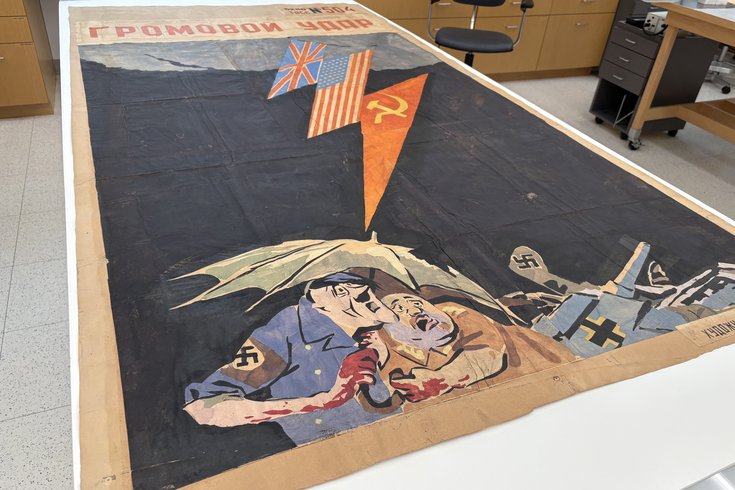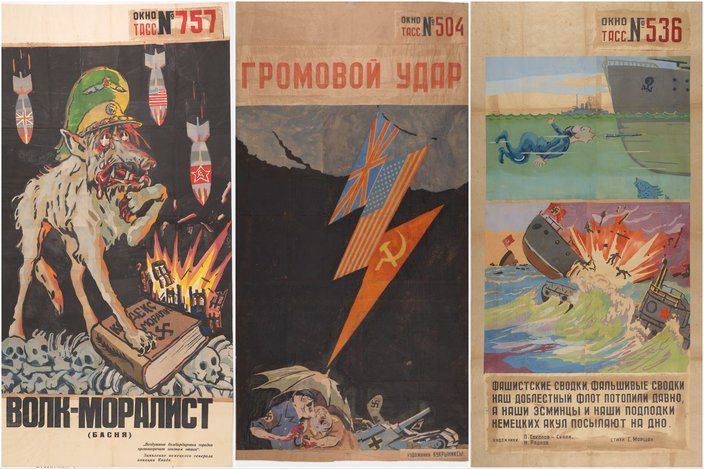
February 24, 2025
 Kristin Hunt/for PhillyVoice
Kristin Hunt/for PhillyVoice
The Philadelphia Museum of Art discovered this and other Russian World War II propaganda posters in its archives last summer. Three will be part of the exhibit 'Boom: Art and Design in the 1940s,' opening April 12.
Last summer, a staffer at the Philadelphia Museum of Art was digging through stacks of 19th century drawings when they stumbled upon something strange. It was a nondescript box with the vague label "miscellaneous Russian." Inside were nine enormous posters, weathered and folded into sixteenths. Though the text was Cyrillic, the imagery was clear: These were World War II propaganda posters promoting the Soviet-U.S. alliance and savaging Adolf Hitler.
"There's not much in storage that's a mystery, right?" said Amanda Bock, a curator of prints, drawings and photography for the museum. "We all know the collections very well, but this box ... I had never looked at it, and it was clear from the condition of these (posters) that they hadn't been looked at in a long time."
Further inspection revealed that the prints were relics of the TASS Window Poster Studio, a Russian propaganda machine that sprang up the same day that Nazi Germany invaded the Soviet Union. Its team of designers, writers, painters and stencil cutters produced 1,415 original designs between 1941 and 1946, which were mass-produced into roughly 700,000 posters that hung in storefronts and, eventually, American museums during the war. PMA will soon display three of its copies in the April exhibit "Boom: Art and Design in the 1940s."
The poster studio, an offshoot of the state-owned news agency TASS, had historical precedent. Russian artists had been sharing folktales through lubki, a form of cheaply produced graphic art, for centuries. But the TASS studio was more directly inspired by ROSTA, the former state news agency that had produced window-length posters during the Russian Revolution. Its descendant would create similar prints to convey news and ideals to the Soviet people.
The TASS studio worked fast, typically turning around a new poster in a single day. The editorial board would meet in the morning to select a theme, based on the latest headlines and government dispatches. Then the artists would get to work, producing a sketch as early as noon. A writer added the caption, and the draft went back to the board — and government censors — for approval. Once they had the green light, the artist would produce a full-scale design for the stencil cutters. That team created a sample for review before turning it over to the stencil painters. They would work through the evening in an assembly line, painting in sections of each individual poster, which was comprised of multiple sheets of paper. By the time they put their brushes down, there were usually hundreds of copies.
After the posters were cut to size and glued together, distributors delivered them to stores, schools, community buildings and theaters, where they'd be displayed the next morning. The studio also created smaller prints for newspapers and magazines, and film rolls for projection onto screens.
"They needed immediacy, but they also needed it to be visually robust and interesting," said Daniella Hsia Bulack, a pre-program conservation intern at PMA who helped restore the posters. "And so the stenciling process allowed them to very quickly respond to ever changing present events."
No two posters were quite alike. Some had lengthy poems or multiple panels, while others kept it simple with a single image and pithy caption. Still, there were common topics and even recurring characters. Fritz, a destructive Nazi youth incapable of thinking for himself, appeared in multiple designs. So did Ivan, a loose-lipped Russian who demonstrated the perils of gossip. The TASS studio was perhaps most focused, however, on Nazi leaders like Hitler, Joseph Goebbels and Hermann Göring.
Its artists and writers could take on a petty tone by mocking the men's appearance, especially relative to their Aryan ideals. Other times, they drew them as weak or pathetic. In one of the art museum's posters, Hitler cowers under an umbrella with Benito Mussolini as a thunderbolt of Soviet, American and British flags strikes.
But more often, the studio rendered the Nazis as grotesque caricatures or animals. Hitler is transformed into a wolf in another print in the museum's collection.
 Provided images/Philadelphia Museum of Art
Provided images/Philadelphia Museum of ArtThe Philadelphia Museum of Art will exhibit three posters from its collection created by the Soviet Union's TASS studio during World War II. From left to right, they are The Moralistic Wolf (A Fable), A Thunderous Blow and Fascist Reports, False Reports.
"The Russians have a humor of their own, but it is not the type which seeks comfort in making a figure of fun out of a deadly enemy," LIFE wrote in 1943. "Their drawings of Nazis are drawings of vermin, not clowns."
While many American journalists were taken aback by the posters' "violent hatred," as the Sunday Times Signal put it, propagandist art became an important point of connection for the Allied forces. Russia had started off the war on the other side of the fight, and the U.S. government was eager to smooth over any lingering wariness. Federal agencies and ambassadors mobilized to send photographs overseas and organize screenings of "The Great Dictator" in the Soviet Union. Russia sent back its TASS posters, which were "immediately shown" in New York institutions like the Metropolitan Museum of Art after not-so-subtle nudges from Washington, according to Bock. Soviet friend groups also aided the effort. The American Russian Institute, headquartered at 908 Clinton St., provided the art museum with one of its prints.
"It became an important practice for the Moscow artists to send the posters abroad as a way of sort of bolstering allyship and combating fascist narratives about the Soviet Union that might still be infiltrating the United States," Bock said. "Famously we were not friendly with the Soviet Union, both before and after the war. So this was a moment of reconciliation and allegiance building."
After the TASS studio closed in 1946, its once ubiquitous posters began fading from memory. The fugue was especially pronounced in America, which soon entered a decades-long Cold War with its one-time ally. As McCarthyism tore through the United States, the prints went into storage at various institutions. PMA wasn't the only one to rediscover them generations later. The Art Institute of Chicago stumbled upon 26 parcels of TASS posters in its archives in 1997, which eventually became an exhibit.
It took a lot of work to get PMA's prints ready for the museum's upcoming exhibit. Hsia Bulack spent the better part of last year testing the posters' paints for solubility, then humidifying and flattening them to remove their deep creases. Small holes and tears were common, too. The repairs required matching paper, paint and brushstroke to patch over the lost pieces, a restoration process known as visual compensation.
Bock hopes that visitors will be as surprised and fascinated by the newly restored posters as she was when "Boom: Art and Design in the 1940s" opens on April 12. This collection demonstrates the ingenuity of wartime artists, she said, who are often lost between prewar and postwar histories.
"There is an incredible amount of work happening with artists working very creatively with limited resources and means to do things," Bock said. "It's an immensely generative production that's happening, and it's a way for people who are unable to enlist to really demonstrate a kind of patriotism, to contribute to the war effort in their own way."
Follow Kristin & PhillyVoice on Twitter: @kristin_hunt
| @thePhillyVoice
Like us on Facebook: PhillyVoice
Have a news tip? Let us know.